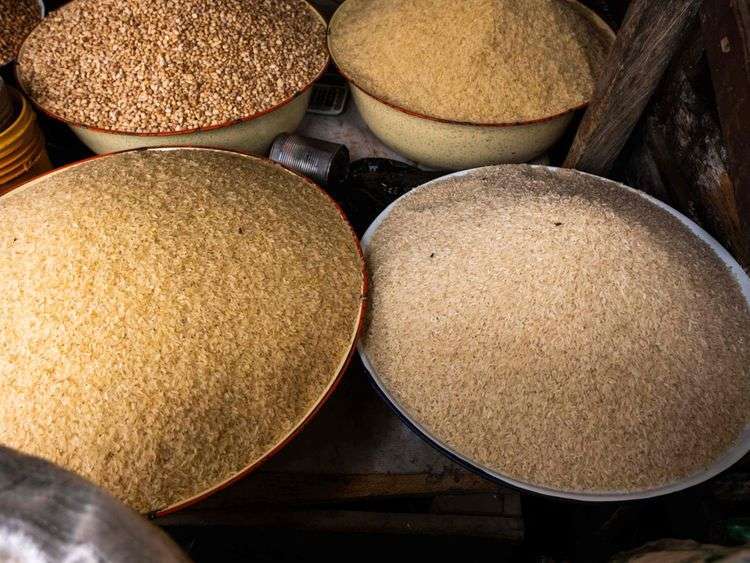Latest News
- Streets, Services, And Infrastructure To Be Developed In Shuwaik...
- Passports Of Kuwaitis Involved In Drug Crimes Abroad Revoked By...
- Right To Privacy And Respect For The Dead
- Compatriots Scam Egyptians
- Mother And Daughter Arrested For Prostitution And Extortion
- Two Male Nurses Break Bones In A Fistfight
- Former Minister Arrested On Arrival Over Graft
- Ministry Of Education Uncovers Salary Payments To Absentees
- Kuwait Banks Seek Clarity From Central Bank On Citizenship Revoc...
- Kuwait Organizes 30 Events To Protect Children From Tobacco Indu...
- Proposal For Residential City South Of 6.5 Ring Road Rejected Ov...
- Gulf Electrical Interconnection Project Will Boost Kuwait's Elec...
Surging Global Food Prices Put Staple Meals Out Of Reach

A year of coronavirus pandemic saw a pot of jollof rice grow steadily more expensive in the Nigerian suburb of Nyanya.
At Nyanya Market, near Abuja, Nigeria’s capital, the price of the rice that forms the base for the dish went up by 10%.
A small tin of tomatoes? Twenty-nine per cent costlier. And the onions? Their price jumped by a third, according to a Nigerian research firm.
Surging consumer food prices are a local problem - and a global one.
FACTORS TO BE BLAMED
A variety of factors are to blame, including a surge in orders from China, fluctuating oil prices, a sliding US dollar, and looming above all: the pandemic, and in some places, reopening.
But experts say that in the face of growing populations, globalization and climate change, higher prices may not be a blip.
In Russia, an increase in pasta prices left President Vladimir Putin boiling. In India, it’s cooking oil, and in Lebanon, bread. In meat-loving Argentina, the cost of some cuts of beef has doubled, and beef consumption is at an all-time low.
The issue has made headlines the world over, including in the United States, where inflation has climbed to 5%, the highest level in 13 years.
The numbers are not rising uniformly, and analysts caution that higher food prices are not always bad news. But when disproportionately increasing food costs intertwine with other economic and social factors, the results can be hard to swallow.
“Even relatively well-off people complain about how food prices are seemingly on an unstoppable tear,” said Feyi Fawehinmi, a Nigerian author and analyst based in Britain.
The UN Food and Agriculture Organization said its food price index, which measures the global price of select foods, had in May hit highs not seen since 2011, up 40% year-on-year.
“This is telling us something about the global food system not being adequate,” said Cullen Hendrix, a professor and director of sustainability initiatives at the University of Denver.
Around the world, the way people eat could change.
Nigeria’s jollof rice price
SBM Intelligence has been tracking the prices of ingredients for jollof rice in Nigeria since 2015, in a “jollof index” that factors in the price of turkey, chicken, beef, seasoning, rice, tomatoes, onions and others.
In its latest quarterly report, the company announced that it had tracked an increase of 7.8% in the jollof index between March 2020 and March 2021. But the price increases were unevenly spread.
Although a few markets saw small declines, others, such as Nyanya, saw the price of a potful jump by nearly 16%. In Lagos, the cost of a bag of onions at a market doubled as producers complained of heists targeting the valuable vegetable.
Fawehinmi said the problem has only become worse. “I have had people I would never have expected ask me for money to buy food recently,” he said.
Nigeria has struggled economically over the past year, with low global oil prices hurting one of its key exports. Unemployment hit 33% in 2020, while inflation has reached more than 18% for the past two months. And “militias have taken over major farmlands and key agricultural transport corridors” in northern states, said Ese Oikhala, a researcher with SBM Intelligence.
Other factors include border closures during the pandemic, designed to stop smuggling of goods including rice, and the devaluation of Nigeria’s currency, the naira.
SOURCE GULFNEWS
Trending News
-
 Expat Residency Law Amended By Kuwait Ministerial...
20 April 2024
Expat Residency Law Amended By Kuwait Ministerial...
20 April 2024 -
 Ministry Announces Separate Time For Amnesty Seeke...
21 April 2024
Ministry Announces Separate Time For Amnesty Seeke...
21 April 2024 -
 The Ministry Connects With Violators Of Residency...
23 April 2024
The Ministry Connects With Violators Of Residency...
23 April 2024 -
 AstraZeneca Admits Covid Vaccine Can Cause Rare Si...
29 April 2024
AstraZeneca Admits Covid Vaccine Can Cause Rare Si...
29 April 2024 -
 Work Permits Will Be Issued For One Year Under The...
27 April 2024
Work Permits Will Be Issued For One Year Under The...
27 April 2024 -
 3 Expats Caught In Salmiya With 213 Bottles Of Loc...
23 April 2024
3 Expats Caught In Salmiya With 213 Bottles Of Loc...
23 April 2024 -
 Temperature Increases Cause Electricity Load Index...
21 April 2024
Temperature Increases Cause Electricity Load Index...
21 April 2024 -
 Al-Nuer Festival Celebrates Kuwaiti Agriculture Wi...
22 April 2024
Al-Nuer Festival Celebrates Kuwaiti Agriculture Wi...
22 April 2024 -
 Peak-time 'cut-offs' Raise Fears Of An Electricity...
22 April 2024
Peak-time 'cut-offs' Raise Fears Of An Electricity...
22 April 2024 -
 Road Trip From Kuwait To Bahrain Via Saudi: Travel...
22 April 2024
Road Trip From Kuwait To Bahrain Via Saudi: Travel...
22 April 2024












Comments Post Comment